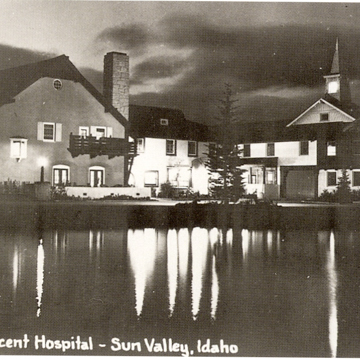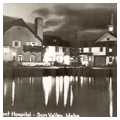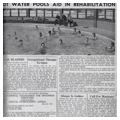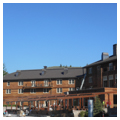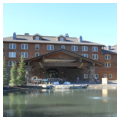Conceived in the second half of the Great Depression, Sun Valley Resort was America’s first destination European-style ski resort. Similar to health spa ski resorts in Switzerland and Austria, Sun Valley offered amenities like mineral spring water, fresh air, nature, recreational sports, and most of all, abundant sunshine. Sun Valley’s target clientele came from the East Coast, where grey winters, icy snow conditions, and long lift lines compromised skiing; winter sunshine, the resort’s dry, powdery snow, and the promise of no lift lines were highly desirable. An afternoon spent soaking in the hot spring pools followed by an evening of movies and mingling with Olympic athletes and Hollywood actors added to the resort’s allure. All of these dimensions were taken into account in the resort’s siting, orientation, programming, and style, in a design meant to heighten the recreational experience.
Looking for a way to increase vacation travel by rail during the Great Depression, Union Pacific Railroad’s CEO Averell Harriman conceived of building America’s first world-class destination ski resort similar to those he had frequented in Europe. To find similar alpine ski conditions, Harriman hired Felix Schaffgotsch, a friend and Austrian count, to scout potential sites in the western United States. During the winter of 1935–1936, Schaffgotsch rejected most of today’s well-known resorts, including Aspen, Park City, Jackson Hole, Tahoe, and Mount Hood, but in February 1936, he determined that Ketchum, Idaho, had all the right conditions for skiing—snow quality, elevation, slope variety, remoteness, sunshine, and hot springs.
At the time, Ketchum was a former mining town that became a ranching center after the silver market crash of 1893. Now, it served as a head spur for the Union Pacific Railroad to load sheep from summer grazing in the nearby mountain ranges. Though the hills and mountain tops in the immediate vicinity of Ketchum are tree topped or covered in sagebrush, ten miles east and northwest in the Boulder and Pioneer mountain ranges the landscape is more vertical and rocky. Thirty miles north are the sublime peaks of the Sawtooths, Idaho’s most photographed mountains. From the ski slopes of Mount Baldy, all these ranges appear close in the crisp mountain air.
After settling on Ketchum, Harriman hired Madison Avenue promoter Steve Hannagan, who had built his reputation promoting the retreat of Miami Beach, Florida. Hannagan’s first recommendation was to name the resort “Sun Valley” in order to attract more patrons through connotations of warmth and light. Hannagan was also playing on the recent discovery of the health properties of vitamin D and the common practice for health spas in the 1930s to promote their days of sunshine. Hannagan wove the sun into all aspects of the resort’s branding, from its logo to its buildings. Precedents like St. Moritz and Davos, Switzerland, appear to have influenced not only Sun Valley’s logo but also the lodge placement and orientation, window size and placement, and the style of the adjacent alpine village.
To design Sun Valley, Harriman hired architect Gilbert Stanley Underwood, who was well known for his lodges in Yosemite, Grand Canyon, Bryce Canyon, and Zion national parks. The Sun Valley Lodge was designed and completed in a record nine months—just in time for guests to check in on December 21, 1936, the winter solstice. Located a mile northeast of downtown Ketchum, the resort site was intended to maximize solar exposure with the lodge catching the last rays of the afternoon sun—a warm place where cattle congregated before the winter sun set behind Bald Mountain, located one and three-quarter miles to the southwest. The lodge embraced the sun in a number of ways from its east-west orientation, large south-facing windows, and multitude of outdoor sunning decks, similar to sanatorium designs. In fact, the many tuberculosis sanatoriums in Davos served as inspiration for the design. Several rooms in the lodge were designated as “Sun Rooms,” including one large room above the lobby and several smaller guest rooms on the ends of the east and west wings, that are surrounded by outdoor sun decks. Ernest Hemingway occupied one of these rooms, his expenses paid by the resort in exchange for the right to photograph his active lifestyle. In photographs from his period of residency, he is depicted working outside on the deck in the morning sun while completing For Whom the Bell Tolls.
Locating the lodge’s hot sulfur pool on the west side assured plenty of warm afternoon sun while soaking and sunbathing after skiing. A wall of windows enclosed the surrounding sunbathing deck to keep out stray breezes, thus enabling sunbathers to comfortably lay out when temperatures dip into the mid-30s Fahrenheit. This was key for the resort’s promotion. Just as Hannagan used images of sunbathers in Miami Beach to lure New Yorkers to South Florida for the winter, he deployed photographs of Sun Valley’s sunbathers against a backdrop of snowy roof tops and mountains.
The lodge’s most distinctive feature is its wood-textured stained concrete that makes it appear as if the building is constructed of overscaled timbers. This is the only Alpine reference in Underwood’s design and he had used the same technique nine years prior in the Awanhee Lodge in Yosemite National Park. Hannagan insisted that the lodge look modern with large view windows and include all the luxuries of more upscale hotels.
After six successful seasons, Sun Valley was drawn into the war effort. On December 20, 1942, the Sun Valley Company cancelled a record number of ski reservations and transformed itself into a U.S. Navy convalescent hospital for treatment of wartime wounds, illnesses, and battle fatigue (now known as post-traumatic stress disorder). What had been promoted as a healthful resort was easily adapted as a hospital. Not only did the dry mountain air help treat malaria, the hot sulfur pools aided in the healing and soothing of painful injuries and illnesses. The quiet and serene mountain setting calmed the nerves of mental patients who made up nearly half the hospital’s population. For morale, the Navy entertained the troops by making good use of the resort’s ice rink, pool, and movie theater. A different movie was shown nightly and iconic movie stars visited the troops in 1944.
In 1946 the resort re-opened to the public with its glamour intact, but it began operating at a loss. As Harriman increasingly turned his attention to public service, he became less involved in Sun Valley, which now faced competition from newer resorts such as Lake Tahoe and Vail. Making matters worse, Union Pacific failed to invest in hotel upgrades that would have kept Sun Valley competitive. In 1964, the railroad finally sold the resort to Los Angeles real estate developer and former Olympic skier Bill Janss.
From 1964 to 1977 Janss expanded the village and condo development. Spending over $11 million, he nearly doubled the number of ski runs. Warm Springs Run and the Warm Springs Hut on the north side of Mount Baldy next to the original Guyer Hot Springs is located two and a half miles from the main resort. This addition spurred the expansion of nearby Ketchum, with an increase in construction of condos and second homes near the Warm Springs base. Sun Valley’s rapid expansion was frequently characterized by lower quality buildings that did not wear well under the tromping of wet ski boots and the wide daily temperature swings of the high desert mountain climate.
Janss sold the resort in 1977 to Earl Holding, chair of Sinclair Oil Corporation and Little America Hotels. Holding’s credo of “anything worth doing is worth overdoing” played itself out for several resort additions throughout his tenure. Starting in 1992, Holding added the Warm Springs Lodge, the first of four mountain ski lodges the architectural firm Ruscitto Latham Blanton designed to replace Janss’s hastily constructed hut on the bottom of Warm Springs Run. The new palatial lodge dwarfed and outclassed the previous hut in space, amenities, and material selection. Built to last, it is constructed of large-scale logs, river stone, and interior finishes of granite and brass. Ruscitto Latham Blanton also upgraded the original hotel lodge and village to accommodate the upscale needs of annual conventions.
In 2008, the Sun Valley Pavilion opened as Holding’s most spectacular addition to the resort. FTL Design Engineering Studio of New York in partnership with Ruscitto Latham Blanton was responsible for a venue that seats over 5,500 and greatly expands upon the original opera house’s role to entertain and elevate the spirit.
References
Holland, Wendolyn Spence. Sun Valley: An Extraordinary History. Ketchum, ID: Idaho Press, 1998.
Mead, Phillip. “Salutogenic environments: The use of culture, light and water for the promotion of health.” World Health Design(April 2012): 60-65.
Maier, M. Claudia, K. G. Maja, Corina H. Conrad-Daubrah D. St. Moritz: History, sport, nature, culture.St. Moritz: AT Verlag, 2002.
Sauter, Van Gordon. The Sun Valley Story.Hailey, ID: Mandala Media, 2011.
Taylor Doris. Sun Valley. Sun Valley, ID: Ex Libris, 1980.
Ward, Stephen. The selling of places: The marketing and promotion of towns and cities 1850–2000. New York: Routledge, 1998.
Underwood, Gilbert Stanley. Sun Valley Lodge As-Built Plans, c. 1937.
United States Navy. “The Mind of the Medic.” Sun Valley Sage, Aug. 4, 1944.
United States Navy. “The Neuro-Psychiatric Dept. in the Rehabilitation Program.” Sun Valley Sage, June 23, 1944.
Zaitlin, Joyce. Gilbert Stanley Underwood: His rustic, Art Deco and Federal Architecture. Malibu, CA: Pangloss Press, 1989.














